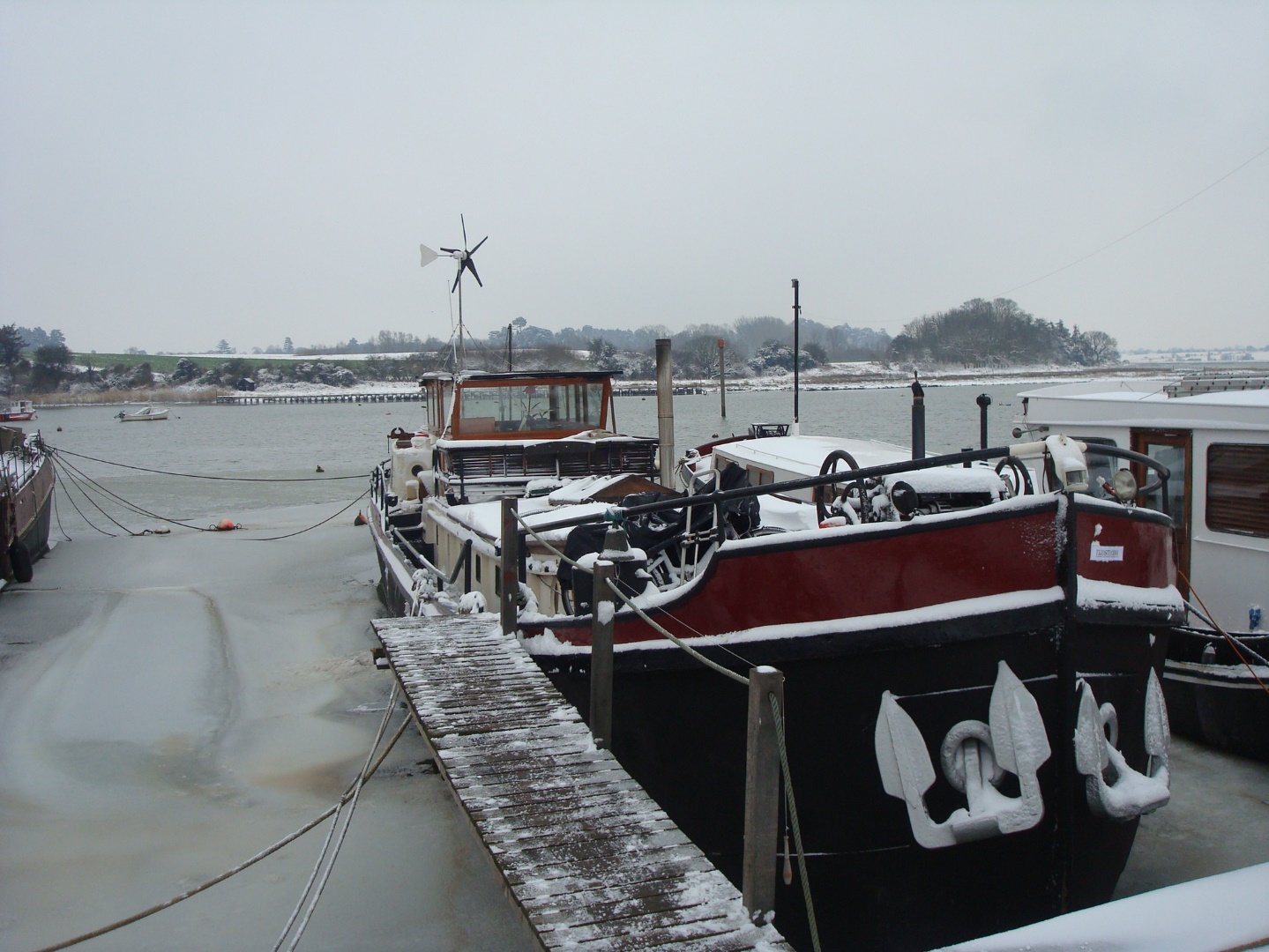By Gary Rogers
In the light of COP26 we should all be questioning our energy use. As boat dwellers we aren’t eligible for government grants and feed in tariffs but that shouldn’t stop us taking steps to a more sustainable energy use.
As an Electronic Design Engineer living afloat for the last 30 years, I have inevitably tried and tested a multitude of off grid solutions, some more successful than others.
Tijdstroom, the Dutch barge Gary and his wife Bev live on, during the 2020-2021 winter
A list of energy sources by cost
| Fuel/Heating Method | Cost / kWh |
| Wind (<1kW) | >£1 |
| Diesel-generated Electric (small genset) | >£1 |
| Log Wood (stacked – air dry 20% *MC) | 22.4p |
| Electric | 19.5p |
| LPG | 15.2p |
| Air Source Heat Pump | 10p |
| Heating Oil | 6.5p |
| Wood Pellets (10% *MC) | 6.1p |
| House Coal | 5.9p |
| Anthracite | 5.7p |
| Ground / Water Source Heat Pump | 5p |
| Natural Gas | 3.8p (for reference only) |
| Solar PV (over 4 years) | 0p (not including installation, and all electric used) |
| *MC Moisture Content |
Wind
My first trials involved wind energy as my company was developing a 5KW, 2.5m diameter blade, variable speed wind turbine. This technology-maintained wind speed with a variable prop speed resulting in increased efficiency and lower prop noise. However, to gain maximum energy, the blades must stay in a laminar air flow. With small units, i.e. suitable for a boat, the nacelle is not locked and is allowed to rotate which plays havoc with the air flow of the blades, not allowing an even lift and thus losing valuable power. Small turbines also have gearless units, meaning the blades pitch must be ridiculously shallow so even though they spin at a high rate, there is never any torque to deliver a decent power. For a fixed nacelle, the extra weight is not cost effective.
Solar
Hot water collectors
These use a marvellous device known as a ‘heat pipe’. Solar energy is collected over a heat plate and a heat pipe transfers the heat to a manifold where a glycol is used to then transfer the heat to a hot water tank. The collector is placed in a vacuum tube to insulate the collected heat, it is an extremely reliable mechanism for converting heat from the sun to hot water. Efficiency is high and is ideal for small roofs but set up costs are also high.
I’ve tried several homemade versions over the years from black silicon pipes to painted radiators, but the efficiency of vacuum tube heat pipes allow the higher temperatures required for a nice shower.
Photo Voltaic (PV)
PV panels are easy to fit, cheap and reasonably efficient and by far the best option of all for renewables on boats. Just one small panel will out pace any wind turbine on your boat and is silent! For heating hot water, they are not as efficient as a solar collector as they require a larger roof, but recently the prices have dropped so much that they are now a cheaper solution than solar collectors. We bought panels 15 years ago, a heavy investment at the time for our Dutch Barge wheelhouse roof – but living off grid as we were at the time it was well worth it.
There are a few types of PV panels; monocrystalline, polycrystalline, and amorphous. The first two are perfectly good but the latter is a short-term solution and will degrade very quickly. Flexible panels are a hybrid of crystalline and amorphous and will initially provide a good power output but will degrade faster and aren’t as reliable as a rigid crystalline panel.
Battery Storage
Capturing the solar energy is only half the story, a good energy storage solution is key to energy efficiency. We often have the most energy in the middle of the day – the time we use it the least. We started with Lead Acid batteries but their lifetime is very short before losing capacity. The efficiency of lithium batteries can make solar installation more attractive. with life span 30x longer than lead acid and efficiency increase from 70% (lead acid) to 95%(Lithium) making them economically viable even with the increased set up costs. The cost of lithium’s is on average 4 to 5 times more expensive but with the efficiency and cycle life they soon pay back. Lead acids are still more economical for engine start as they have very low cycle requirements. Lithium batteries do require a Battery Management system, that can be complicated to setup.
If you can utilise all the energy from your panels – have a battery pack matched with your consumption, then this can be a long-term green solution which is competitive with the grid.
There are two main chemistries of Lithium batteries: Cobalt based, which are lightweight but hazardous and use rare earth elements, and LiFePO4 which are safe, cheap and bulky, ideal for boats.
Insulation
It’s quite hard to measure the cost effectiveness of insulation as there are always too many variables to work out the direct impact of spending hard earned money on something that may be a long-term repayment. Also, for boats it’s quite difficult to purchase a thick piece of insulation knowing the resulting loss of living space.
I wanted to give examples of heating costs for a boat with alternative forms of insulation, but also give you the tools to calculate your own boat costs savings.
There are three terms to get familiar with:
The thermal conductivity (λ, lambda) of a material is the rate at which heat is transmitted through a material, but this term does not say over what thickness!
Thermal resistance (R value) is the resistance of heat flow and is equal to the thickness (in meters) divided by the conductivity. The higher the R value, the more efficient the insulation. Construction materials individual values can be added together to give one R value.
Thermal transmittance (U value), is a measure of the rate of heat loss, which is simply the reciprocal of the ‘R’ value so U=1/R. The U value can be multiplied by the total surface area of your boat and the temperature difference from inside to outside. This will give us the power required to heat the space which is equivalent to how much is being lost.
Here are a few lambda values that may help in your calculations.
Foam Insulation Board = 0.022 (is common Polyisocyanurate or PIR insulation)
Spray Foam Insulation = 0.025 (averaged)
Rock Wool / Glass Wool / Wool / Hemp / Polystyrene / Fiberglass = 0.032-0.04 (not advised for boats, condensation off steel can accumulate and once wet is very hard to dry)
Wood = 0.15
Glass = 1.05 (double glazing important, having the widest glaze gap possible)
Silvered bubble wrap often used as an insulator is not – it’s a radiant barrier and draft sealer.
Example
For a boat size of 20m long, 3m wide, 2m high (and therefore a surface area of 212 m2), at temperatures of 5oC outside and 15oC inside (and therefore a difference of 10oC):
With 10mm (0.01m) of PIR insulation, R = 0.01/0.022 = 0.45. The U value is 1/0.45 = 2.2 W/(m2 K). Multiplying the U value by surface area and temperature difference is 2.2 × 212 × 10 = 4.66kW. With electric at 20p/kWh, 4.66 × 0.2 = 93p/hour.
20mm PIR = 47p/hour
60mm PIR = 15p/hour
60mm Rock Wool = 25p/hour
Building regulations that boaters don’t have to adhere to but give a good reference require a ‘U’ value of the wall of no worse than 0.3, roof 0.16, and floor 0.22. So, a wall must have at least 75mm, roof 140mm and floor 100mm of PIR insulation. One thing writing this article has taught me, is that my 60mm insulation is still not enough!
You can now substitute your boat dimensions for present and future insulation material and work out saving on your bank account and the environment. There is 0.233kg CO2 saving for every kWh.
A look at the future.
There are new insulation materials that are currently used on the space station that have a lambda value of 0.014, which halves the insulation thickness that we currently have.
The government wants us all to have ground source heat pumps, we could double up the mooring posts to act as vertical heat pipes that are required to go down 30m or so depending on topology. Already being done in houses with small gardens.
Water source heat pumps are a new alternative, there are companies starting to sell these, as long as we have a decent depth off water around us then we simply suck in the sea water extract some heat and pump it out again.
Stoves or boilers could be used with Peltier modules using the Seebeck effect to use the wasted heat gradient to generate free electric.
These are a few of the possibilities for the future. Meanwhile, on board Tijdstroom we are using a mix of solar panels, storage via lithium batteries and insulation to keep us warm in winter and reduce our dependence on the grid.
Gary Rogers
Gary and Bev Rogers live on board the Dutch barge Tijdstroom (see The Deben #62, Spring 2021). For more information on Lithium batteries please contact Gary at Unit 5, The Granary, Melton Boat Yard. His company is Aerotech Projects Ltd: visit the website lithiumbatteryshop.uk, or email [email protected].


